This post may contain affiliate links. Please read our disclosure policy.
This flavorful loaf of gluten free sourdough bread is made with the simplest wild yeast gluten free sourdough starter. Your basic loaf of sandwich bread, no commercial yeast needed.
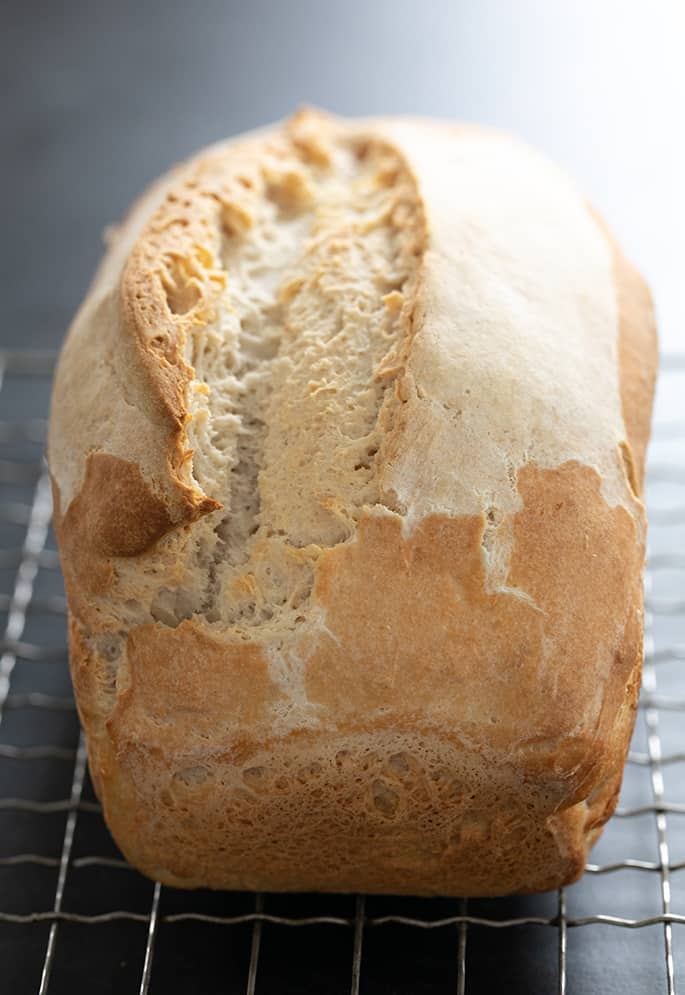
Why make pure wild yeast gluten free sourdough bread?
This recipe for a standard loaf of gluten free sourdough bread and our simplified recipe for gluten free sourdough starter are not designed to be a deep dive into all things sourdough. Our goal here is much simpler.
Indeed, this is a loaf of authentic gluten free sourdough bread, made without any commercial yeast at all. But these recipes are designed to scratch the itch for a fuller-bodied yeasty tasting bread, and to help you enjoy fresh homemade bread if you don't have any commercial yeast.
Think of it more like a workhorse kind of white sandwich bread that's great for lunches. In my bread book, GFOAS Bakes Bread, I have a whole chapter on wild yeast sourdough recipes and we go deep.
Here, we go simple. The rules are a little relaxed, but the process takes less work. And frankly I believe that the deep dive in Bakes Bread really illustrates why I still love traditional cookbooks that can really explore a whole subject.
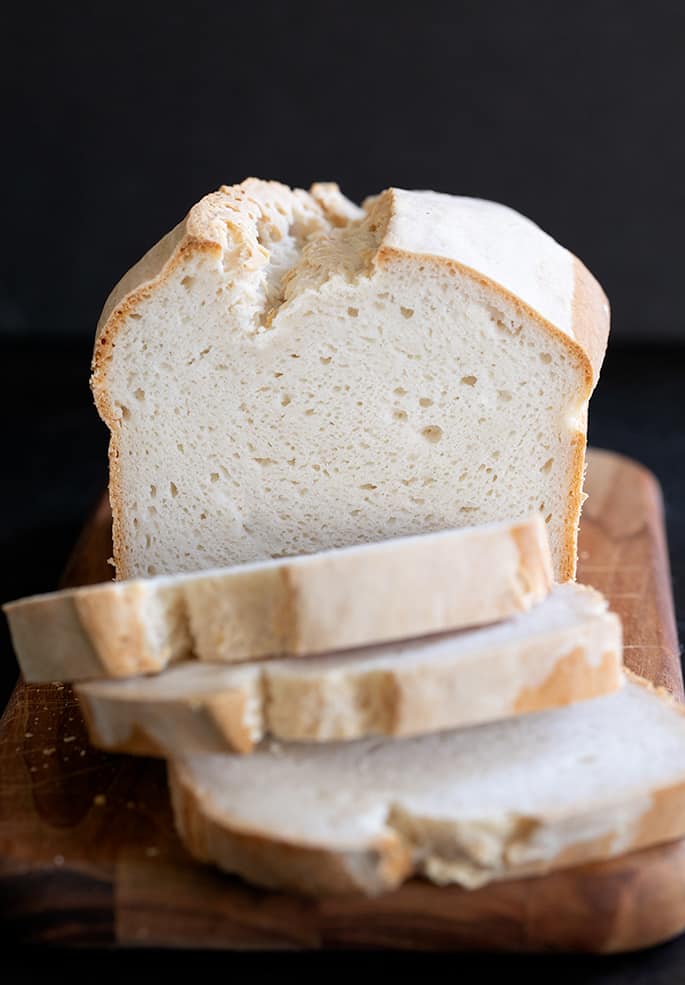
How to bake gluten free sourdough bread
How to use a gluten free sourdough starter
Before we begin discussing how to make bread with your active, fed wild yeast sourdough starter, let's first make sure you have one (click thru earlier in this paragraph)! If you don't, no worries at all you've come to the right place.
Keep in mind that a wild yeast sourdough starter (one made without any commercial yeast, which is a single strain of yeast) takes at least 5 days to become active. And it will perform best after about 10 days.
You can speed things up by adding a bit of commercial yeast to your starter. If you have commercial yeast on hand and you need a loaf of bread today, I recommend our simplest gluten free bread recipe.
But if you've been confused by sourdough starters in the past, try to stick with us. We've simplified the process significantly, so click through above.
It includes an instructional video to bring it to life, and frequently asked questions to help soothe your worried sourdough soul.
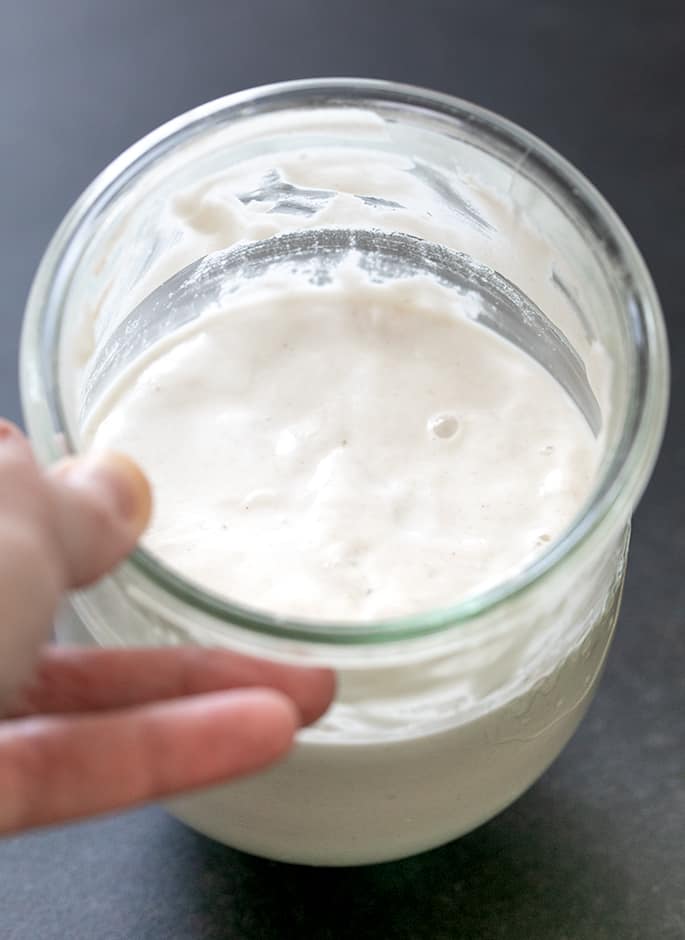
How to feed your gluten free sourdough starter for use
Your starter must have been “fed” or “refreshed” within the previous 12 hours for it to work in this recipe. Do not proceed with an active starter that hasn't been fed recently. The yeast will have consumed its available food and simply won't be active enough to give a proper rise to a whole loaf of bread.
Once your starter is mature and active, it will need to be refreshed or fed at least once a week to keep it active. That way, when you are ready to bake with it, the wild yeast is alive and waiting for you.
To refresh or feed your sourdough starter, either to keep it active once a week or because you are preparing to bake with it:
- Remove your mature starter from the refrigerator.
- Discard about 1/3 of the volume (including any clear liquid or hooch from the top).
- Add 1/2 cup (70 grams) gum-free gluten free flour and 1/2 cup (4 fluid ounces) spring water or distilled water. Mix with a nonreactive spoon.
- Cover the starter and allow it to sit, covered, at room temperature for about 2 hours or until it is bubbling and active. It is now ready to use in baking.
- Once you've removed the amount of active, fed starter that you need for baking, repeat the process to feed or refresh the starter, then cover it again and allow it to sit on the counter for 12 hours before returning it to the refrigerator for another week, until it needs to be fed again.
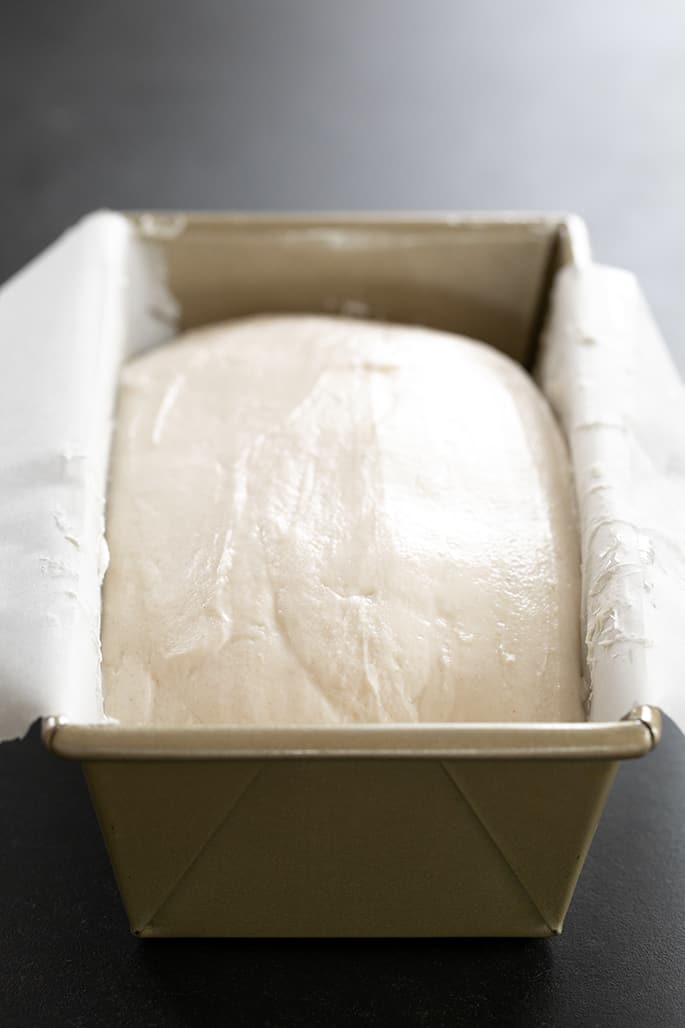
Gluten free sourdough bread: ingredients and substitution suggestions
Gluten free dairy free sourdough bread
You should be able to replace the dairy in this bread recipe successfully. The milk can be replaced with unsweetened nondairy milk (my favorite is almond milk), or even with water. If you replace the milk with water, your loaf will simply be a bit less tender but it should still rise.
I haven't tried replacing the butter with a nondairy replacement, but you should be able to use your favorite vegan butter alternative. I only recommend using a butter alternative like Melt or Miyoko's Kitchen brand vegan butter or Earth Balance, and not oil.
Tapioca starch/flour
When I was first testing this recipe, I made it with 3 1/2 cups of all purpose gluten free flour, and the dough didn't rise as readily and the crumb was tighter. I much prefer the recipe made with 1/2 cup of tapioca starch/flour.
If you don't have tapioca starch, you can try using arrowroot in its place, or even another 1/2 cup of all purpose gluten free flour. I'm afraid I can't predict exactly what results you'll get, though.
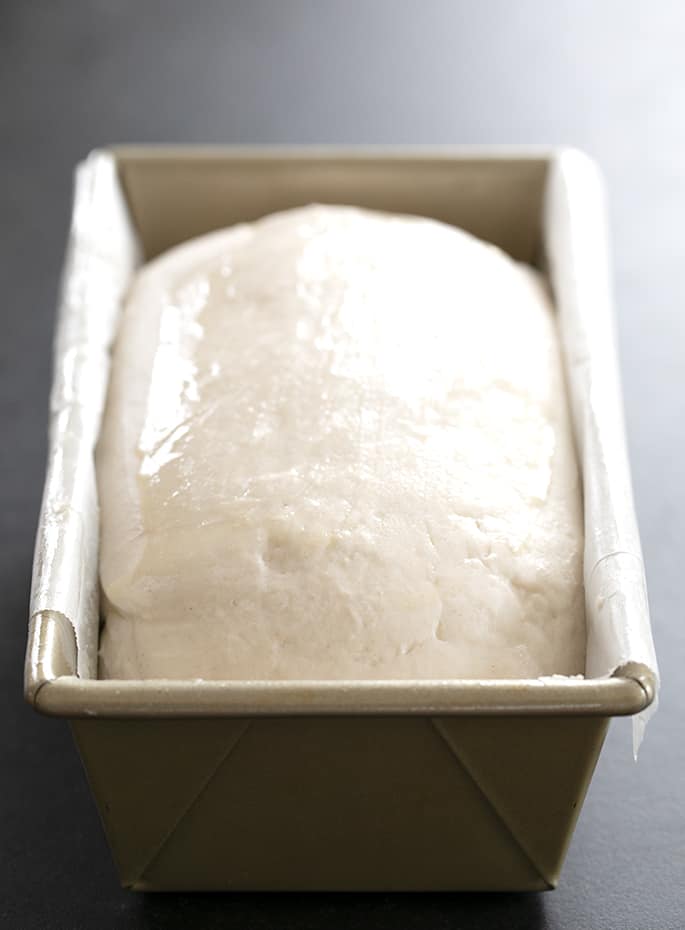
FAQs
Since this bread is made with a very simple, liquid sourdough starter, it will not rise like the breads in Bakes Bread. If you have that book, turn to the opening section of the sourdough chapter. You'll find a photo of sourdough bread dough that literally popped like a can of biscuits when I opened it after its refrigerator rise.
This recipe is for a batter-style bread, not our bread recipes that call for the more complex gluten free bread flour so it has only one rise. And produces a more ordinary loaf. But when you're baking with limits, “ordinary” can be amazing, especially when it comes to fresh homemade bread.
This rise takes quite a bit of time. In all of my recipe testing, I'm yet to see a rise that took less than 3 hours, and have even let it rise for 8 hours without overproofing.
If you’re unsure about whether or not the bread has proofed enough, allow it to keep rising.
The dough should rise to about 150% of its original size when it's done proofing. That means that it should be 50% bigger than when it started. Unlike conventional bread, this loaf will not double in size, or rise to 200% its original size. Unlike bread made with conventional yeast, it will have more oven spring, where the yeast speeds up the fermentation process in the beginning of baking before a crust forms, so it will get considerably bigger during baking.
Overproofed dough like this tends to have little dimples on the surface, and that tends to take much longer to happen here than it does in a recipe made with conventional yeast. Once those dimples start to form, your bread shouldn't rise any longer.
Yes, since this recipe rises so slowly without overproofing, you can make the dough before bedtime, shape it in the loaf pan, cover the pan, and set it to rise during the night. When you wake up, bake the loaf and enjoy. You can also start the process in the morning, let it rise and bake about an hour before dinnertime.
When this loaf is done baking, the center of the loaf will read 200°F on an instant read thermometer and the loaf will sound hollow when thumped quickly on the underside with a finger.
How to make gluten free sourdough bread
Gluten Free Sourdough Bread Recipe
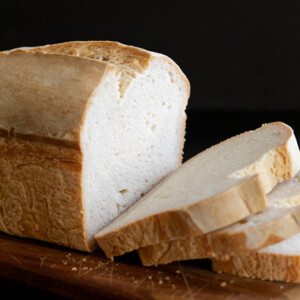
Equipment
Ingredients
- 3 cups (420 g) all purpose gluten free flour blend, (I used & highly recommend Better Batter; click thru for details)
- 1 ½ teaspoons xanthan gum, omit if your blend already contains it
- 9 tablespoons (68 g) tapioca starch/flour
- 2 tablespoons (25 g) granulated sugar
- 1 ½ teaspoons (9 g) kosher salt
- ¾ cup (165 g) gluten free wild yeast sourdough starter, fed within previous 12 hours (See Recipe Notes)
- 1 ½ cups (12 fluid ounces) warm milk, (about 95°F), plus more by the tablespoon
- 4 tablespoons (56 g) unsalted butter, at room temperature
Instructions
- Grease a standard 9-inch x 5-inch loaf pan and line with parchment paper. Set the pan aside.
- In the bowl of a stand mixer fitted with the paddle attachment or a large bowl with a hand mixer fitted with dough hooks, place the all purpose flour, xanthan gum, tapioca starch/flour, granulated sugar, and salt, and mix or whisk to combine well.
- Add the starter, 1 1/2 cups of milk, and the butter, and beat on medium speed to combine. This is a batter-style bread dough, so it won’t resemble traditional bread dough, but rather a soft cookie dough.
- Turn the mixer up to medium-high speed and beat until the dough has taken on a whipped appearance (about 5 minutes). The dough should be tacky to the touch, but should hold its shape when scooped.
- If your dough feels at all dry to the touch, add more milk by the tablespoon, beating it in until well-combined, until the dough reaches the proper consistency.
- Transfer the bread dough to the prepared loaf pan. Using a moistened spatula, press the dough into every corner of the loaf pan and spread the top into an even layer.
- For a more traditional loaf shape, pile the dough a bit more toward the center in a dome.
- Cover the loaf pan with lightly oiled plastic wrap and allow it to rise in a warm, draft-free place until it’s reached about 150% of its original size, at least 4 hours. It will not fully double in volume, and will rise more in the oven than it does raw.
- Even traditional yeast bread dough will take longer to rise properly in colder, drier weather and less time in warmer, more humid weather.
- This wild yeast sourdough bread will take longer to rise than any other, and will depend in part upon the age of your starter.
- This bread dough is much less likely to overproof and take on that pock-marked appearance than bread made with conventional yeast. If you’re unsure about whether the bread has proofed enough, allow it to keep rising.
- When the bread is nearing the end of its rise, preheat your oven to 400°F.
- Remove the plastic wrap and, using a sharp knife or lame, slash the top of the loaf from one short end to the other about 1/4-inch deep.
- Place the pan in the center of the preheated oven and allow to bake for 30 minutes.
- Reduce the oven temp to 350°F, rotate the pan 180° around, and continue to bake until center of the loaf reads 200°F on an instant read thermometer (about 30 minutes more).
- The crust won’t darken very much, but the loaf should sound hollow when thumped quickly with a finger.
- Remove the pan from the oven and allow the bread to cool for about 10 minutes in the pan before transferring to a wire rack to cool completely before slicing and serving.
- To freeze the bread, cool the loaf completely, then slice, wrap tightly and freeze the slices. Defrost as many slices at a time as you need in the toaster.
Video
Notes
- Remove your mature starter from the refrigerator.
- Discard about 1/3 of the volume (including any clear liquid or hooch from the top).
- Add 1/2 cup (70 grams) gum-free gluten free flour and 1/2 cup (4 fluid ounces) spring water or distilled water. Mix with a nonreactive spoon.
- Cover the starter and allow it to sit, covered, at room temperature for about 2 hours or until it is bubbling and active. It is now ready to use in baking.
- Once you've removed the amount of active, fed starter that you need for baking, repeat the process to feed or refresh the starter, then cover it again and allow it to sit on the counter for 12 hours before returning it to the refrigerator for another week, until it needs to be fed again.
Nutrition information is automatically calculated, so should only be used as an approximation.
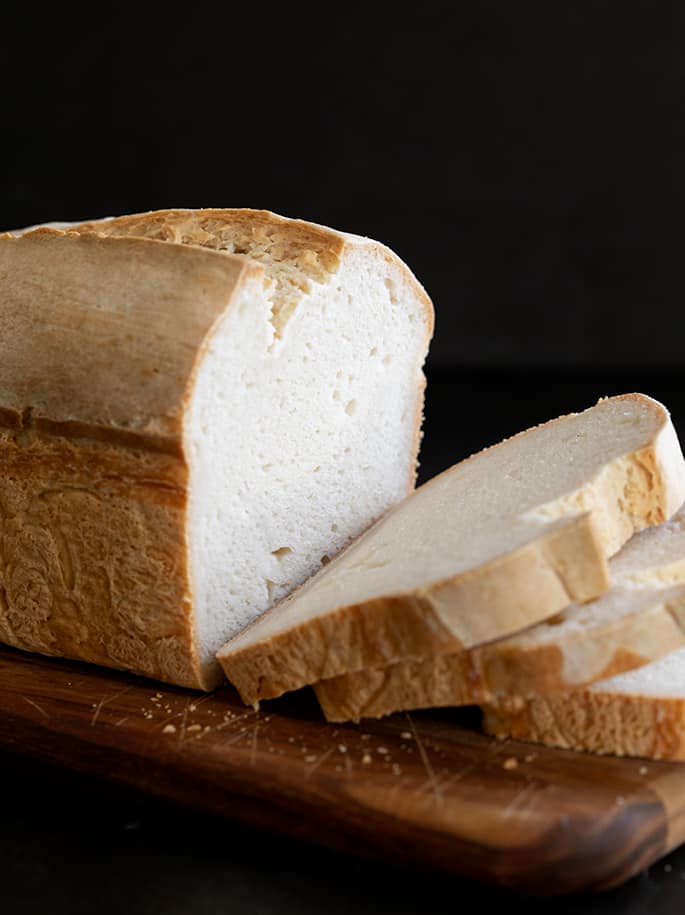
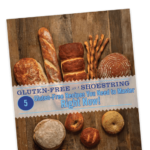
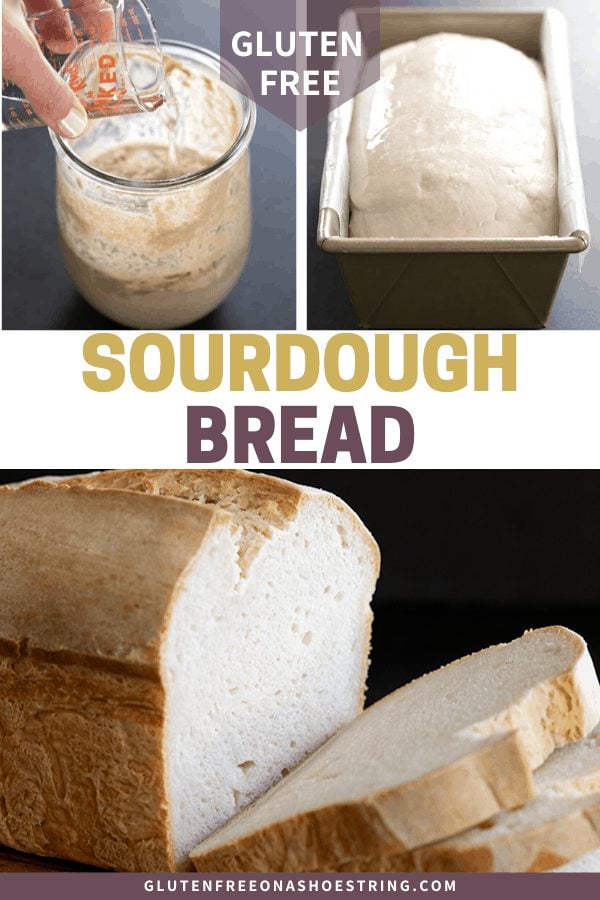
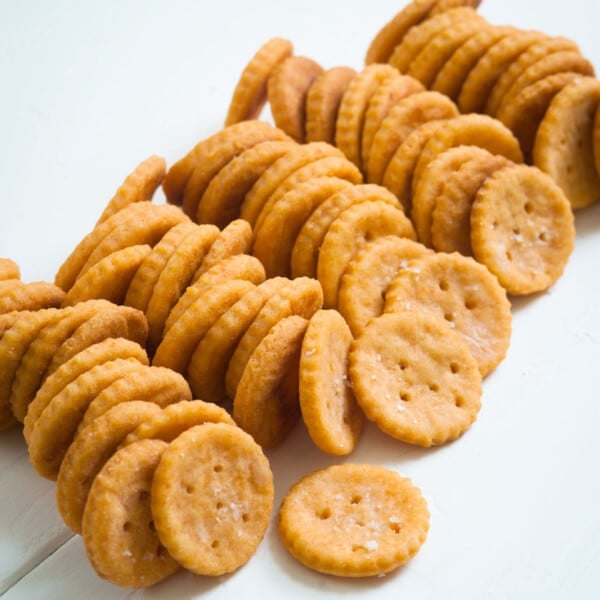
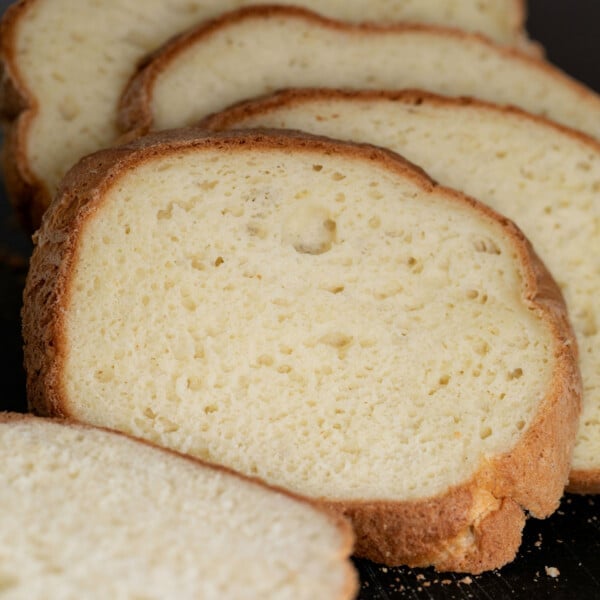
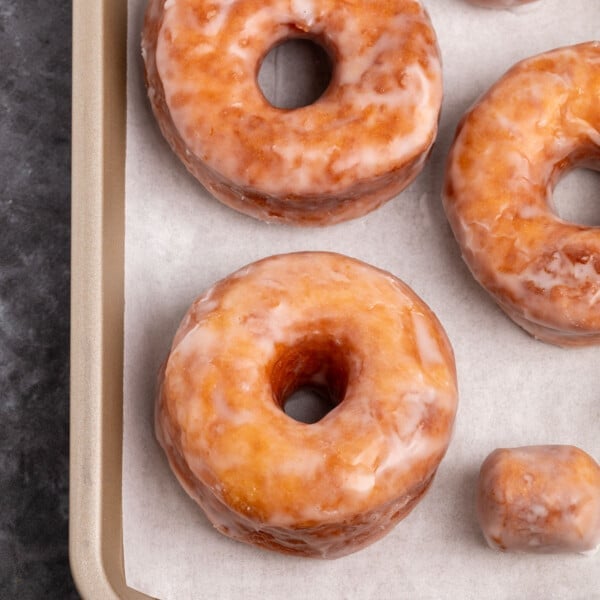
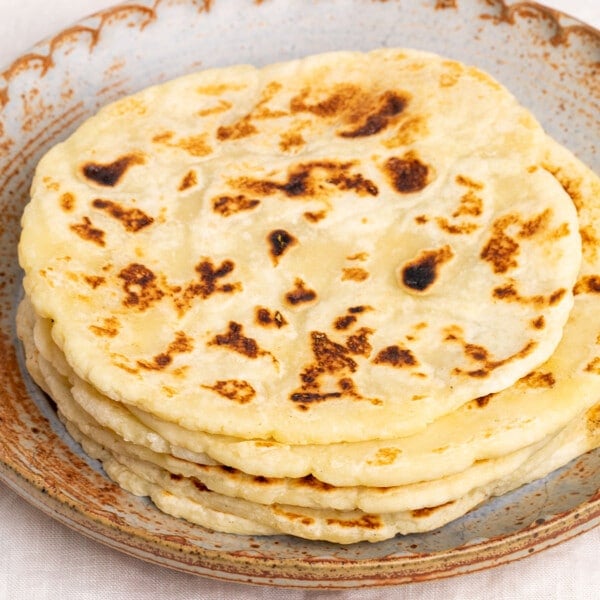









Hello,
I followed the recipe, had to allow the dough to rise over night as 4 hours wasn’t enough, but it then did rise it did quite well. Baked as per recipe in the morning, middle reached a little over 200F, let it cool with the open oven. Removed after an hour of so. Then cut a slice off about 2 hours later whilst still warm. Everything seems and looks great but the texture is a little doughy and heavy still, did I do something wrong? I’m guessing it should be lighter and not doughy?
You absolutely have to let it cool completely before slicing into the bread, Sam. It’s even more important with this bread than with traditional GF yeast breads. And it also sounds like you may not have baked it quite long enough, but the “still warm” part is likely the main problem!
This turned out absolutely amazing! I used Pamelas All-Purpose flour blend and subbed canned coconut milk as I didn’t have any regular. I will make this again and again.
Hola for Canada
What great recipe! made it for my husband yesterday and its all gone in one day! The wild yeast was so easy and had it ready to go in only six days. Am so impressed that I ordered your bread book [have to wait a whole month to get it but under the circumstances it is more then understandable.] Thank you so much for your wonderful work! It been one hole year since he was diagnosed and I wouldn’t of survived without your wonderful recipes. Thank you from the bottom of my heart and God bless you and your family!
Thank you so much for the kind words, Ana. I’m so glad everything worked out so well for you! It sounds like wild yeast is your friend for sure. There is a whole chapter on sourdough breads in the bread book (thank you for buying that, by the way, and so sorry for the wait!), but it uses a different method and I haven’t tried to convert the blog wild yeast starter to a “mother starter” which is what is used in the bread book. You’ll love the bread book, though! So many options!
Hi Nicole, I made the bread yesterday, the bread was stretchy when I pulled it apart and it looked like the starter was working as evidenced by the small air bubbles in the bread but it didn’t rise enough and the bottom was still looking dense and uncooked. I had it rising for 6 hours before baking and this morning as I’m rereading the blog, you indicated it might take up to 8 hrs to rise. My GF sourdough starter was just one week old, had lots of bubbles and I did refresh it yesterday after using some of it for the bread and placed it in the refrigerator this morning. I used Bob’s Red Mill 1 to 1 baking flour. I have the Better Batter now but didn’t want to waste it on my first attempt. Any thoughts as to the lack of rise?
I’m afraid it’s your flour. You simply can’t use Bob’s Red Mill flour blends in my recipes. It won’t work. If you’re concerned about wasting ingredients (which you won’t if your starter is active and you’re patient with allowing the bread to rise as long as it needs), try cutting the entire recipe in half and baking it in a smaller container (a smaller loaf pan if you have it). Bob’s Red Mill blends are not welcome around here. ?
Nicole,
I have your GFOAS Bakes Bread book, and I’m in the process of making the wild yeast starter. It’s developing well, and I’m really excited! But tomorrow is Day 4, and unlike this simple starter recipe on the blog, the last step occurs on Day 4. Can I keep the liquid starter going for a few more days by repeating Stel 4? I only ask because I am waiting on getting Expandex in the mail, and it’s due to arrive on Friday. Thanks!
Absolutely, Suzanne! I’m excited for you. ?
So today I am going to make sourdough bread….very excited. My starter has been going for 10 day’s and lots of yeast activity and smell. Question for you Nichol….do you think I could put the dough into a round baneton and let it rise for hours and then just before cooking put it on a cookie sheet and cook? Scared to ruin a loaf today so maybe put my loaf pan and try another day but just wondered what you thought.
I have to be honest, Sher, I’ve only used a banetton for the bread recipes in my bread book, GFOAS Bakes Bread, which are made with a different base that behaves much more like conventional bread. I don’t see why a banetton wouldn’t work for this recipe, but I’m afraid I can’t promise.
I want to try the sourdough, but am a little nervous. And the cupboard is bare (of bread, anyway) so today I tried your Japanese milk bread. It is fabulous! It’s by far the best gluten free bread I’ve made. Maybe the best I’ve ever tasted. I made a mistake, though, and used 1 and 1/2 cups of milk. The dough was too soft to shape and I just had to put it in my short, deep pullman pan and cross my fingers. Success!
Thank you!
Debbie Krueger
So glad you enjoyed the Japanese milk bread. I’m pleasantly surprised that it ever baked all the way through with all that liquid! Don’t be nervous about the sourdough. Read through the starter post a few times and get a feel for the whole concept. That helps a ton.
Hooray, sourdough starter! When I was diagnosed with Celiac 8 years ago, I had to give up my beloved starter, which I had for many years. I am so excited to try this. I have my starter going for 3 days and I can’t wait to bake bread, hopefully this weekend.
Nicole, you and your site are a trusted resource and friend!
Hi, Ellen, I absolutely love your enthusiasm! It’s so fun when it starts to work, isn’t it? I’ve been testing more sourdough recipes, since there’s so much fun to be had, but nothing has been up to snuff just yet. Keep feeding!
Hi Nicole! I made this today with my brown rice starter that’s about 4 months old. I’ve been trying various recipes and experimenting with flour combinations, nothing reliable yet. This loaf, however, has smelled more amazing with every passing hour (I let it rise for 6-7 hours). I put it in a Pullman pan and though the rise was very modest (to about half the pan height), when it was done the loaf had risen to the top of the pan! I only noticed then that I’d forgotten to score the top and the loaf had split in the middle of the sides, so once out of the pan it deflated pretty thoroughly. Based on past experience (especially with better batter) I’m expecting a somewhat gummy loaf (also my oven may have been too hot to start- I misplaced my oven thermometer last week), but from the impatient little tastes my husband and I tore off the jagged, poking out corner of the loaf… I’m certain this is a new favorite worth another few attempts to learn what it wants from me.
Thank you so very much for this simplified gf sourdough. God bless you and your family!
Tastes good, no issues with starter (6 days old when used) but bottom of loaf is soggy, despite finished temperature of 205F. Thoughts? Thanks!
Since I’m not there with you I’m afraid it’s not possible for me to know for sure, but without knowing more my top guess is that it simply wasn’t baked long enough. I’d also make sure your oven is as hot as your gauge says it is, and that you take the loaf out of the pan to cool on a wire rack and allow it cool completely before handling it any further.